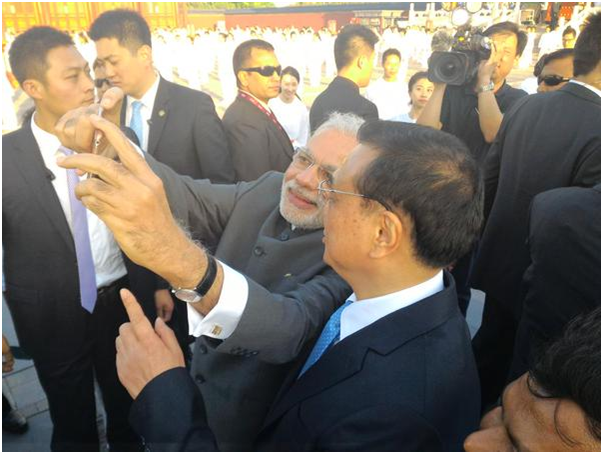China And India Skirt Around Each Other; Selfies Do Not Eclipse Arunachal, Kashmir
Yet another Selfie
NEW DELHI: It is an accepted fact, by both China-baiters and supporters, that little happens in the Land of the Dragon that is not deliberate. So when the state owned television channel flashes images of a map of India, without Arunachal Pradesh and Jammu and Kashmir, even as India’s Prime Minister Narendra Modi was signing 24 agreements with Chinese President Xi Jinping in Xi’an, there is clearly something amiss. And the host country has basically, once again flagged, the ‘status quo’ where it is concerned even as it moves forward on $10billion trade agreements.
So far PM Modi and his delegation to China have not reacted adversely, with the red carpet treatment clearly dulling responses. In fact, the government has chosen to take the position that the media does not reflect the Chinese government position. PM Modi said the “principle of mutual and equal security” should be brought into tackling the boundary issue. And that it “should settle it in manner that transforms our relationship and not cause new disruptions."
He further said that,”a shadow of uncertainty always hangs over the sensitive areas of the border region. It is because neither side knows where the Line of Actual Control is in these areas." The boundary issue was discussed at length by both sides, and it was agreed to increase the currently four Border Personnel meeting points; and activate hotlines between the military headquarters.
The social media, however, is abuzz with comment about the controversial map that was shown during a news program on the visit, and underlined the rigid Chinese position that has extended from claiming Arunachal Pradesh to including Jammu and Kashmir.The map came just two days after an article, in the state run Global Times newspaper where Indians were described as “inferior.” The article claimed that PM Modi was playing with China on the border issue.
India’s emphasis through the visit has been on the emergence of both as “major equal powers”. However, it remains to be seen whether new ground has been broken over the boundary issue that remains ‘vexed’ and clearly a disruption in the full normalisation of ties. China that had shown some flexibility on the Arunachal Pradesh issue earlier has revised its policy to go back to the 2006 position that the “entire state of Arunachal Pradesh is disputed”. It refers to Arunachal Pradesh as “southern Tibet.” The map thus on state owned television was a re-assertion of this position.
On Jammu and Kashmir too China has been revising its policy since the days of Mao Zedong where Partition in 1947 was seen as “unnatural” to support of self determination for Kashmiris in the 1960’s to a peaceful resolution of the issue by India and Pakistan in the 1980’s. However, by financing strategic projects in Gilgit, Baltistan and the Pakistan administered Kashmir China has laid open its intentions to Indian question. India claims that China has occupied 38,000 square kilometres of its territory at Aksai Chin plateau.
China’s policy to build ‘buffer zones’ in South Asia is also of worry to India. It has made inroads in Bangladesh, Sri Lanka, Nepal, Afghanistan, Myanmar and the Maldives much to India’s chagrin. Interestingly, China is the largest arms supplier to Pakistan. Both sides discussed the possibility of military cooperation on humanitarian assistance and disaster relief in the backdrop of the Nepal earthquake where both countries were active as competitors.
The visit is ongoing and while full stock can only be taken after it is over, the first signals suggest that forward movement is on the business deals, with the strategic issues being placed on hold with just a few minor frills such as hotlines being agreed upon. The Foreign secretary that this would be taken up “soon” but admitted that even on this there was no time frame.





